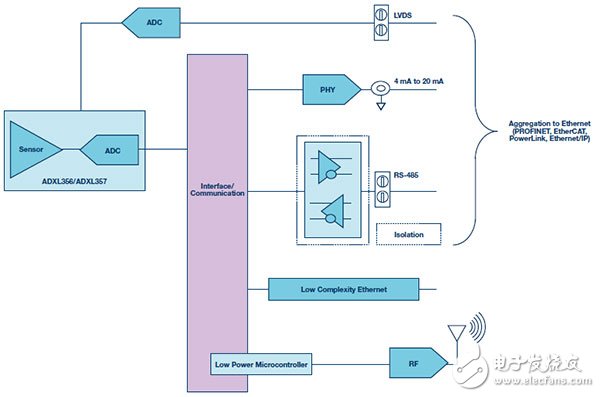The writer is Thomas Brand, Field Application Engineer, Analog Devices
Currently, a paradigm shift that is frequently referred to as Industry 4.0 (called Industrie 4.0 in Germany) is taking place. In international use, terms such as (industry) Internet of Things, smart factories, or information physics (production) systems refer to the same thing, and they are often used interchangeably. Industry 4.0 refers to the global trend of industrial value chains and their products moving towards digitization and networking.
In particular, the German Industry 4.0 is not only highly regarded in the business world. Due to its economic impact, Industry 4.0 is also politically driven, such as further developing the competitiveness of German manufacturing. In this case, government officials are promoting a dual strategy that combines a supplier perspective with a user company perspective, with the main areas being industrial automation and factory engineering. To this end, manufacturers must use the latest technology for their own production processes, and on the other hand, put these technologies and products on the market.
From the perspective of leading suppliers, the integration of information or communication technologies with traditional high-tech methods is mainly to expand the production sector and its technology. In order to achieve this expansion, it is necessary to meet the preconditions of increasing market momentum and market complexity. From a manufacturing perspective, it is important to design smart technologies and products for new markets and serve them accordingly. In order to meet the needs of suppliers and manufacturers, companies need to take into account these two perspectives. For example, companies in the semiconductor industry are very good at using such dual strategies.
Semiconductor manufacturers such as Analog Devices are digesting this complex concept and turning their production lines into fully automated smart factories. In addition, these manufacturers provide innovative technologies to other companies in the manufacturing industry to help them transform their manufacturing facilities into smart factories. As a result, SMEs have been given an important role, accounting for the vast majority (more than 98%) of German industrial companies. What kind of support is possible, what challenges semiconductor manufacturers face, and what opportunities will Industry 4.0 bring – these issues are discussed below.
Companies need to judge whether turning their production facilities into smart factories is a futile effort, or will actually increase productivity and reduce costs.
In order to find answers to the following key questions, many market research companies have conducted a lot of research. They all came to the same conclusion: Industry 4.0 will add value to SMEs, and they should seize the opportunity to consolidate the company's success. Especially for semiconductor manufacturers, the research results can be divided into three areas: new technologies, new products and new business models. All three aspects together cover the entire value chain of production and its products – from sensor nodes through the cloud to downstream services.

Figure 1. Signal chain of a smart factory.
Figure 1. Smart Factory Signal Chain
In order to achieve a smart factory transformation, smart and energy-efficient products, or completely autonomous systems, must be provided that can be easily integrated into existing production structures (eg plug and play). These systems consist of a variety of semiconductor devices and sensors and are combined with analog and digital signal processing ICs. The value chain begins with these devices: First, the sensors are responsible for collecting data from the real physical world, then converting them into digital signals and processing them in the digital domain (see Figure 1).
What are the new requirements?As the value chain develops, market demand will need to change. That's why semiconductor manufacturers have to adapt their businesses and products to smart factories. Technology trends are moving towards smart energy-efficient products and integrated safety and security functions and energy harvesting capabilities. A device or a complete system is shown in Figure 2, using the Analog Devices MEMS-based accelerometer ADXL356 as an example.
The ADXL356 is a low cost, low noise, 3-axis accelerometer with a measurement range of ±40 g (FSR). The main features of this device are ultra-low offset drift and low power consumption. Due to its hermetic package, the ADXL356 is ideal for accurate tilt measurements in harsh environments, high-resolution vibration measurements, and high-performance (long-term) measurements in low-current or battery-powered wireless sensors for structural health monitoring (SHM), Attitude and Heading Reference System (AHRS) or other applications with sudden excessive force. The ADXL356 is the basis for a system and can be extended with other functions: integrated signal processing with analog-to-digital converters, microcontrollers, and various analog, digital (partial isolation) or wireless interfaces, supporting Ethernet, 6LpoWPAN or ADRadioNet, etc. Communication standard. ADRadioNet is a communication standard developed by Analog Devices. It features a wireless self-healing multi-hopping communication protocol with high scalability and low memory consumption. In addition, it also integrates encryption methods (such as AES-128 and AES-256) to prevent possible network attacks and improve security. Last but not least, functional safety plays an important role in the development of these systems, as it is also very important for smart factories.
For semiconductor manufacturers, it is not enough to expand the variety of sensors and other semiconductor devices in the future. In order to become a global player in the market and to fully exploit the potential of Industry 4.0, its existing product range must be extended through communications and low-power microprocessor technology. With this in mind, Analog Devices has provided related solutions in its portfolio. For example, in the field of communications, there are a variety of solutions using HART® modems. By using existing infrastructure to implement new energy-saving technologies, these HART solutions can improve traditionally crowded communication networks in a fairly simple way.

Figure 2. MEMS-based smart sensor soluTIon.
Figure 2. MEMS-based smart sensor solution
Market research also shows that SMEs want strong support from manufacturers and suppliers to integrate new products into their systems faster and more efficiently. In this way, companies can reduce the amount of extra work and continue to focus on their core business. In particular, cooperation or collaborative efforts between suppliers and enterprises are of the type of support.
Although Industry 4.0 has many advantages, the question now is why many companies have not yet invested in smart factories.
Hesitant reasonOne of the main obstacles to investment is that companies have not realized that smart factories will bring benefits, so they are not willing to pay related costs. For example, due to the lack of monetization assessment criteria, it is still quite difficult to calculate the investment rate. Therefore, semiconductor manufacturers must raise customer awareness, provide educational materials to illustrate the advantages of smart factories, and point out the value that investment in smart factories can achieve.
However, not only SMEs interested in turning their facilities into smart factories need to invest, but smart solution providers like semiconductor manufacturers must invest in their own products and, if possible, reorganize their businesses. department. These investments are necessary for new technologies and business models, as well as for developing and expanding marketing campaigns, qualification measures, and sales management.
With the transformation of the production sector, data and IT security will play an important role. These aspects are not only important requirements for the successful introduction of Industry 4.0, but should also be continuously implemented in the digital system as a key success factor.
For companies, it is important to develop basic strategic routes and collect relevant technical experience in the early stages of the implementation of Industry 4.0. However, this process requires patience because many related technologies may take 5 years, 10 years or more to fully demonstrate their potential. Therefore, the implementation of Industry 4.0 will take a long time. Moreover, due to the lack of a clear definition, Industry 4.0 will be fully realized and there is no exact date. Instead of talking about the "industrial revolution," it might be more meaningful to use "industrial evolution."
As the production environment changes, new players and competitors will also appear or influence the market. The alliance is about to emerge and will have a major impact on shaping the image of production. In the future industrial or enterprise buildings, there will be fewer and fewer people. Software and services will also play an important role, because only by connecting and integrating virtual reality with the real world can it provide tremendous production potential.
Obviously, for enterprises, they are accelerating the current pace of development. If they miss the opportunity, they will have a hard time catching up.
Therefore, companies no longer believe that Industry 4.0 is a temporary hype. At the same time, the current market clearly shows the irreversible development trend of Industry 4.0 and smart factories. The biggest problems in terms of lack of standards, lack of security, and lack of knowledge are getting smaller and smaller. In addition, confusion about the future production environment is also decreasing.
In short, the transformation of the Industrial 4.0 Smart Factory and the technology it requires have created enormous possibilities and success for semiconductor manufacturers.
Second-Hand Power Generator,Power Generator,Diesel Generator,Electric Generator
Shaoxing AnFu Energy Equipment Co.Ltd , https://www.sxanfu.com
